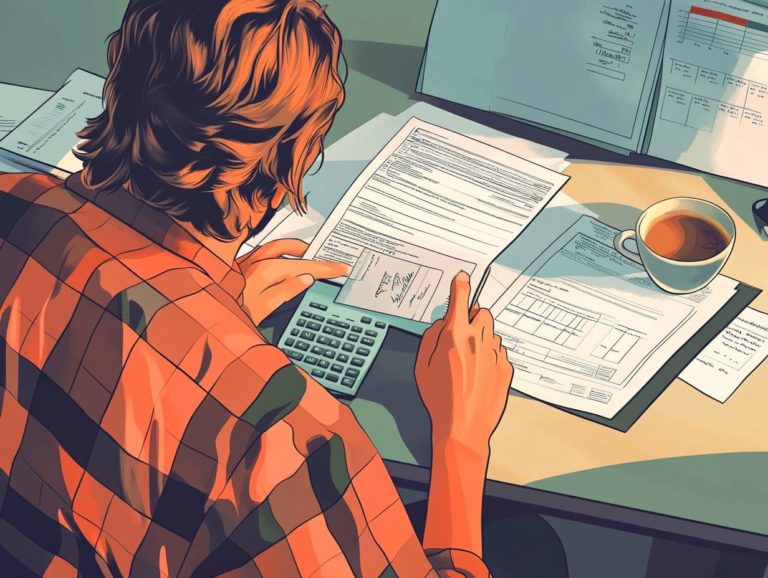Understanding 1099-K Forms for Freelancers
Navigating the realm of freelance income can be quite the challenge, particularly when tax season rolls around. One document that frequently raises eyebrows is the Form 1099-K.
This guide will help you navigate the essentials of the 1099-K form quickly and easily! You ll discover what it is, who receives it, and how to acquire it. You ll also learn what steps to take when tax season arrives, common pitfalls to watch out for, and alternatives worth considering. Understanding how payment processors work is crucial for freelancers.
Whether you re stepping into the freelancing world for the first time or simply seeking a refresher, this information will illuminate your responsibilities and help you maintain financial clarity.
Contents
- Key Takeaways:
- What is a 1099-K Form?
- Who Receives a 1099-K Form?
- How to Obtain a 1099-K Form
- What to Do with a 1099-K Form
- Common Mistakes to Avoid with 1099-K Forms
- Alternatives to 1099-K Forms
- Other Tax Forms for Freelancers
- Frequently Asked Questions
- What is a 1099-K form?
- Will I get a Form 1099-K?
- What income is reported on a 1099-K form?
- Do I need to report all my income on a 1099-K form?
- What should I do if I don’t receive a 1099-K form?
- Do I need to include a 1099-K form with my tax return?
Key Takeaways:

- Freelancers must report income from clients through a Form 1099-K, which serves as a record of their earnings and is used for tax purposes, especially when receiving payments through payment apps.
- Eligibility for receiving a 1099-K form depends on meeting certain requirements and working with specific types of clients or platforms.
- It is crucial for freelancers to accurately report and file their 1099-K forms by the designated deadline to avoid penalties and ensure proper tax compliance.
What is a 1099-K Form?
The Form 1099-K is a critical tax document introduced by the IRS, meticulously crafted for reporting payment transactions processed by third-party networks such as PayPal and Venmo. Its primary purpose is to ensure transparency in income reporting, especially for freelancers and businesses that accept payments via credit cards, debit cards, and payment apps.
This form details all transactions that need to be reported exceeding a specified reporting threshold, making it essential for maintaining tax compliance and ensuring your record-keeping is accurate for your tax return.
Definition and Purpose
The Form 1099-K is your official record for transactions that need to be reported via various payment networks, ensuring you remain compliant with IRS requirements whether you run a business or are self-employed.
This essential document sheds light on the total payments you’ve processed through credit cards, third-party payment services, or platforms like PayPal. Its primary role is to enable transparent reporting of both taxable and non-taxable income, helping you accurately assess your financial obligations.
For example, while some transactions might be taxable, others could be completely exempt, like reimbursements or personal gifts. Grasping how to interpret this form is vital, as misreporting can result in significant penalties and audits. This underscores the necessity of precise financial documentation to uphold your tax compliance.
Who Receives a 1099-K Form?
If you receive payments through third-party payment processors such as PayPal, Venmo, and others, you may receive a Form 1099-K once your transactions surpass the IRS reporting threshold. This is essential for maintaining accurate records.
This ensures that all relevant income is properly documented for tax purposes, keeping your finances in order and compliant.
Eligibility and Requirements
To qualify for receiving a Form 1099-K, you must meet certain IRS requirements, particularly concerning a minimum number of reportable transactions or a dollar amount that exceeds the threshold established by the IRS.
For example, if you’re self-employed or earning business income, you’ll typically need to report at least 200 transactions and receive more than $20,000 in payments through third-party networks like PayPal or credit card processors. This means that if you frequently engage in online sales, freelance work, or gig economy jobs, you’ll want to closely monitor your transaction count and overall revenue. Additionally, understanding tax forms for freelancers can help you navigate your responsibilities more effectively.
Factors such as the types of payments you receive whether credit card payments or other electronic transactions play a significant role in determining your eligibility for this important tax form, helping you ensure compliance with IRS regulations and reporting requirements.
It’s crucial to file your 1099-K forms on time to avoid penalties!
If you have questions about your eligibility or how to report your income correctly, consider consulting a tax professional for personalized advice.
How to Obtain a 1099-K Form

To obtain a Form 1099-K, keep diligent records of your transactions throughout the year. Your payment processor, like PayPal or Venmo, is required to issue this form by specific deadlines. They will keep you informed about your reportable transactions and help ensure effective tax compliance.
Process and Deadlines
The process of obtaining a Form 1099-K culminates in your payment processor preparing the form and submitting it to both the IRS and the recipients by designated deadlines.
Maintaining accurate and detailed records of all transactions is essential. Any errors could complicate your tax return filing. Each payment processor has its own timeline, typically ensuring the form is sent out by January 31 of the following year. Therefore, whether you’re an individual or a business, regularly reviewing your transaction history is crucial to ensure accuracy.
This proactive approach not only streamlines your tax filing process but also lets you address potential issues from incorrect or missing data. Ultimately, this aids in your compliance with IRS regulations.
What to Do with a 1099-K Form
Upon receiving your Form 1099-K, understanding how to report the income detailed within is essential. This understanding carries significant tax implications for both your freelance and business income when it s time to file your tax return.
Reporting and Tax Implications
Reporting income from your Form 1099-K on your tax return requires clarity on how it fits into your overall income, especially if you are self-employed. Ensure there are no inconsistencies that could raise red flags and trigger an audit.
Filing accurately is vital, as many individuals might not fully appreciate the implications of this form. It consolidates payment information from various transactions and platforms. Beyond simply reporting this income, explore potential deductions that can help lighten your tax burden. Expenses like transaction fees, equipment purchases, or even home office costs could be relevant, and understanding tax returns for freelancers can provide valuable insights.
Documenting these expenses meticulously is equally important. Any inaccuracies or omissions can lead to penalties, interest, or even an audit. Keeping thorough and organized records is not just beneficial for validating income and expenses; it also safeguards you against potential legal complications.
Common Mistakes to Avoid with 1099-K Forms
When navigating Form 1099-K, several common mistakes can obstruct accurate reporting. These errors could lead to discrepancies and complications with the IRS. Recognizing these pitfalls is crucial for ensuring full compliance with reporting requirements.
Tips for Accurate Reporting

To ensure accurate income reporting on Form 1099-K, embrace practical tips centered around diligent record keeping, understanding IRS reporting requirements, and regularly reconciling your transaction records.
One key strategy is to meticulously categorize the payments you receive, clearly distinguishing between reportable and non-taxable transactions. This can significantly enhance the accuracy of your filings. Utilizing software or digital tools will streamline your financial document organization, making retrieval and review much easier.
By regularly reviewing your reports, you can identify errors early, allowing you to resolve issues before they escalate. Taking these proactive steps helps you manage your financial reporting responsibilities effectively, ultimately reducing the likelihood of errors or audits related to Form 1099-K.
Alternatives to 1099-K Forms
While Form 1099-K is essential for many individuals, several alternatives are available for reporting income. This is especially relevant for freelancers, who can utilize various tax forms based on their specific revenue streams and payment methods.
Start reviewing your transaction records today to ensure smooth filing tomorrow!
Other Tax Forms for Freelancers
Freelancers navigate various tax forms, including Schedule C and Form 1099-K. These forms are essential for accurately reporting income and expenses to the IRS.
You might also need to use Form 1040, which serves as your personal income tax return, along with Schedule SE, which helps calculate the tax you owe as a self-employed person. It’s vital to check that Form 1099-K, which reports payment card and third-party network transactions, matches your own records to ensure everything adds up correctly.
If you have specific expenses, you might need to file Form 8829 to claim home office deductions. This highlights the importance of meticulous record-keeping to meet distinct reporting requirements. By using these forms correctly, you can manage your taxes more easily.
Frequently Asked Questions
What is a 1099-K form?
A Form 1099-K is a tax document used to report income received from payment card transactions and third-party network transactions. It is typically used by freelancers and other self-employed individuals to report their income to the IRS.
Will I get a Form 1099-K?

As a freelancer, you might get a Form 1099-K if you ve received at least $20,000 in payments. This also applies if you had over 200 transactions using payment cards or third-party platforms like eBay in a calendar year.
What income is reported on a 1099-K form?
A Form 1099-K reports income received from payment card transactions, such as credit card, debit card, and PayPal transactions. It includes income received from third-party network transactions, such as online payment platforms like Venmo or Stripe, and income for goods or services provided through platforms like Uber and Lyft.
Do I need to report all my income on a 1099-K form?
No, you only need to report income received from payment card transactions and third-party network transactions on a Form 1099-K. Other sources of income, including non-taxable payments, should be reported on other tax forms, such as a 1099-MISC or Schedule C.
What should I do if I don’t receive a 1099-K form?
If you believe you should have received a Form 1099-K but did not, contact the payer and request a copy. If you still don t receive one, you can report your income using your own records. The IRS will cross-reference it with the payer’s records, especially under IRS requirements set forth in the American Rescue Plan Act.
Do I need to include a 1099-K form with my tax return?
You do not need to include a Form 1099-K with your tax return. However, keep a copy for your records and use it when filing your taxes to ensure accuracy, particularly for the tax years 2023 and 2024.






